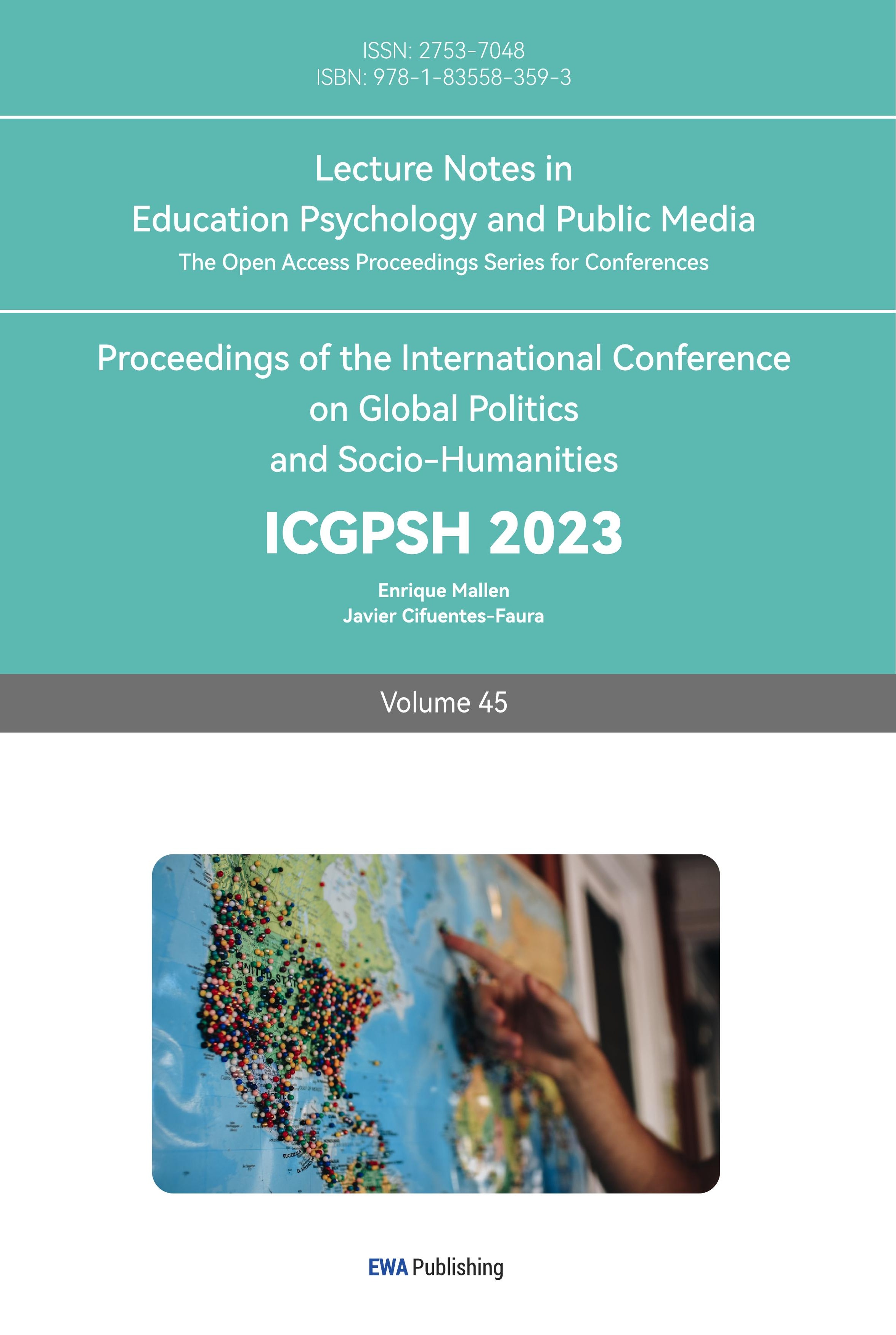References
[1]. Abdullaev, Z., & Isanova, V. (2022). Teaching of Spoken English in Non-Native Context [Preprint]. SSRN. https://doi.org/10.2139/ssrn.4291660
[2]. Morley, J. (1991). The Pronunciation Component in Teaching English to Speakers of Other Languages. TESOL Quarterly, 25(3), 481. https://doi.org/10.2307/3586981
[3]. Pennington, M. C., & Richards, J. C. (1986). Pronunciation Revisited. TESOL Quarterly, 20(2), 207. https://doi.org/10.2307/3586541
[4]. Wei, M. (n.d.). A Literature Review on Strategies for Teaching Pronunciation.
[5]. Agarwal, C., & Chakraborty, P. (2019). A review of tools and techniques for computer aided pronunciation training (CAPT) in English. Education and Information Technologies, 24(6), 3731–3743. https://doi.org/10.1007/s10639-019-09955-7
[6]. Du, H., & Guan, H. (2016). Hindrances to the new teaching goals of College English in China: Being contextually blind and linguistically groundless, current tertiary ELT policy needs to be redefined. English Today, 32(1), 12–17. https://doi.org/10.1017/S0266078415000462
[7]. Zhang, F., & Liu, Y. (2014). A study of secondary school English teachers’ beliefs in the context of curriculum reform in China. Language Teaching Research, 18(2), 187–204. https://doi.org/10.1177/1362168813505940
[8]. Woodrow, L. (2006). Anxiety and Speaking English as a Second Language. RELC Journal, 37(3), 308–328. https://doi.org/10.1177/0033688206071315
[9]. Juniper Stokes. (2008). The Effects of Music on Language Acquisition.
[10]. Rais, B., Pranowo, D. D., & Sari, Rr. P. I. P. (2020). The Use of Song in Teaching English Pronunciation. Proceedings of the 1st International Conference on Language, Literature, and Arts Education (ICLLAE 2019). 1st International Conference on Language, Literature, and Arts Education (ICLLAE 2019), Yogyakarta, Indonesia. https://doi.org/10.2991/assehr.k.200804.025
[11]. Zhang, S. (2016). Mobile English Learning: An Empirical Study on an APP, English Fun Dubbing. International Journal of Emerging Technologies in Learning (IJET), 11(12), 4. https://doi.org/10.3991/ijet.v11i12.6314
[12]. Böttger, H., & Költzsch, D. (2020). The fear factor: Xenoglossophobia or how to overcome the anxiety of speaking foreign languages. Training, Language and Culture, 4(2), 43–55. https://doi.org/10.22363/2521-442X-2020-4-2-43-55
[13]. Liu, X. (2010). Arousing the College Students' Motivation in Speaking English through Role-Play. International Education Studies, 3(1), p136. https://doi.org/10.5539/ies.v3n1p136
Cite this article
Zhang,X. (2024). Exploring the Improvement of Chinese Junior High School Students' English Capacities in Oral Speaking. Lecture Notes in Education Psychology and Public Media,45,37-41.
Data availability
The datasets used and/or analyzed during the current study will be available from the authors upon reasonable request.
Disclaimer/Publisher's Note
The statements, opinions and data contained in all publications are solely those of the individual author(s) and contributor(s) and not of EWA Publishing and/or the editor(s). EWA Publishing and/or the editor(s) disclaim responsibility for any injury to people or property resulting from any ideas, methods, instructions or products referred to in the content.
About volume
Volume title: Proceedings of the International Conference on Global Politics and Socio-Humanities
© 2024 by the author(s). Licensee EWA Publishing, Oxford, UK. This article is an open access article distributed under the terms and
conditions of the Creative Commons Attribution (CC BY) license. Authors who
publish this series agree to the following terms:
1. Authors retain copyright and grant the series right of first publication with the work simultaneously licensed under a Creative Commons
Attribution License that allows others to share the work with an acknowledgment of the work's authorship and initial publication in this
series.
2. Authors are able to enter into separate, additional contractual arrangements for the non-exclusive distribution of the series's published
version of the work (e.g., post it to an institutional repository or publish it in a book), with an acknowledgment of its initial
publication in this series.
3. Authors are permitted and encouraged to post their work online (e.g., in institutional repositories or on their website) prior to and
during the submission process, as it can lead to productive exchanges, as well as earlier and greater citation of published work (See
Open access policy for details).
References
[1]. Abdullaev, Z., & Isanova, V. (2022). Teaching of Spoken English in Non-Native Context [Preprint]. SSRN. https://doi.org/10.2139/ssrn.4291660
[2]. Morley, J. (1991). The Pronunciation Component in Teaching English to Speakers of Other Languages. TESOL Quarterly, 25(3), 481. https://doi.org/10.2307/3586981
[3]. Pennington, M. C., & Richards, J. C. (1986). Pronunciation Revisited. TESOL Quarterly, 20(2), 207. https://doi.org/10.2307/3586541
[4]. Wei, M. (n.d.). A Literature Review on Strategies for Teaching Pronunciation.
[5]. Agarwal, C., & Chakraborty, P. (2019). A review of tools and techniques for computer aided pronunciation training (CAPT) in English. Education and Information Technologies, 24(6), 3731–3743. https://doi.org/10.1007/s10639-019-09955-7
[6]. Du, H., & Guan, H. (2016). Hindrances to the new teaching goals of College English in China: Being contextually blind and linguistically groundless, current tertiary ELT policy needs to be redefined. English Today, 32(1), 12–17. https://doi.org/10.1017/S0266078415000462
[7]. Zhang, F., & Liu, Y. (2014). A study of secondary school English teachers’ beliefs in the context of curriculum reform in China. Language Teaching Research, 18(2), 187–204. https://doi.org/10.1177/1362168813505940
[8]. Woodrow, L. (2006). Anxiety and Speaking English as a Second Language. RELC Journal, 37(3), 308–328. https://doi.org/10.1177/0033688206071315
[9]. Juniper Stokes. (2008). The Effects of Music on Language Acquisition.
[10]. Rais, B., Pranowo, D. D., & Sari, Rr. P. I. P. (2020). The Use of Song in Teaching English Pronunciation. Proceedings of the 1st International Conference on Language, Literature, and Arts Education (ICLLAE 2019). 1st International Conference on Language, Literature, and Arts Education (ICLLAE 2019), Yogyakarta, Indonesia. https://doi.org/10.2991/assehr.k.200804.025
[11]. Zhang, S. (2016). Mobile English Learning: An Empirical Study on an APP, English Fun Dubbing. International Journal of Emerging Technologies in Learning (IJET), 11(12), 4. https://doi.org/10.3991/ijet.v11i12.6314
[12]. Böttger, H., & Költzsch, D. (2020). The fear factor: Xenoglossophobia or how to overcome the anxiety of speaking foreign languages. Training, Language and Culture, 4(2), 43–55. https://doi.org/10.22363/2521-442X-2020-4-2-43-55
[13]. Liu, X. (2010). Arousing the College Students' Motivation in Speaking English through Role-Play. International Education Studies, 3(1), p136. https://doi.org/10.5539/ies.v3n1p136









